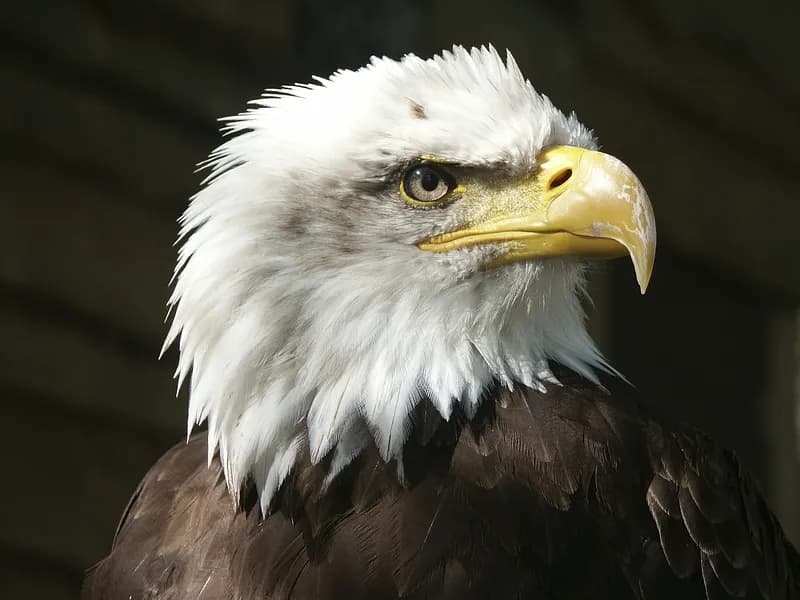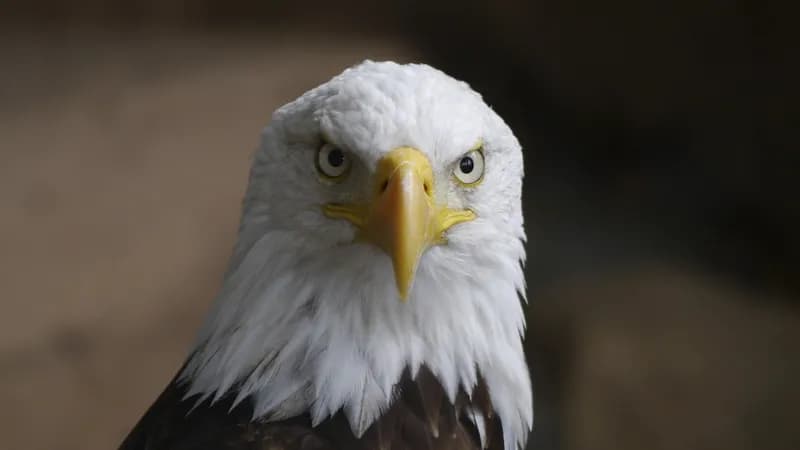Eagles and other birds of prey have the best visual acuity of any group of animals. It is four to eight times better than ours. A soaring eagle can spot a rabbit from 2 miles (3.2 km) away.
The remarkable vision of an eagle is the result of key adaptations in its eyes. Eagle eyes have over one million cone cells per mm2 compared to human eyes with 200,000 cone cells per mm2. When an eagle swoops down on its prey at 100 mph, the muscles in its eyes continuously adapt the curvature of the eyeballs to maintain a crisp focus and precise depth perception.
9 Key Facts About Eagle Eyes
- Eagles and hawks have the best vision of any vertebrate species.
- Eagles have a remarkable 20/5 or 20/4 visual acuity, which means that they can see things from 20 feet away that we humans would only see from 5 feet away.
- Eagles can spot a fish or rabbit from 2 miles away. Imagine spotting a medium pizza that far away!
- Eagle eyes have one million cone cells per mm2 compared to 200,000 per mm2 for human eyes.
- An eagle’s eye has two focal points, or fovea, one pointed forward and the other to the side.
- Eagle eyes are huge; the eyes of a 10-pound (4.5-kg) eagle may be as large as those of a human weighing 200 pounds (90.7 kg). Sometimes a bird’s eyes are heavier than its entire brain!
- Eagle eyes fill their entire sockets and are fixed in place.
- An eagle must turn its head to look to the side and can swivel its head nearly 270 degrees.
- Eagles have a 340-degree field of vision with peripheral eyesight superior to humans.
- Eagles have evolved the ability to quickly change the shape of their cornea and lens to focus on both near and far objects at high speed.
Why Do Eagles Have Such Amazing Visual Acuity?
An eagle can see an animal the size of a rabbit about 2 miles (3.2 km) away.
A rabbit is roughly the size of a medium pizza. Imagine being able to spot a pizza from 2 miles away! And pizzas don’t normally hide camouflaged under bushes!
This remarkable visual acuity is made possible by the tubular shape of the eye, a huge pupil, retinas with cones, and a significantly deeper fovea, a structure in the back of the eye that is rich in cones.
Raptors, including falcons, hawks, and eagles, have two retinal regions specialized for acute vision in each eye: the deep fovea and the shallow fovea. In contrast to the deep convex pit found in hawks and eagles, the human fovea is like a little shell or bowl.
The deep fovea’s (nasal fovea) line of sight is forward and approximately 45 degrees to the right or left of the head axis, while the shallow fovea’s line of sight is forward but approximately 15 degrees to the right or left of the head axis.

According to the anatomy of the foveae, the deep fovea (nasal fovea) has the highest acuity, especially useful for viewing objects from a long distance. According to researchers, their eyes can operate like telephoto lenses by magnifying objects in the center of their fields of vision thanks to their deep fovea.
However, the precise function of each fovea is uncertain. The vitreous in the deep fovea may act as a third lens, increasing magnification to the optic system.
In comparison to an eagle’s central fovea, which has over a million cone cells per square millimeter, a human’s fovea has roughly 200,000 cone cells per square millimeter. This dense concentration of cone cells provides eagles with the best vision of any vertebrate species.
Some researchers believe that the space between the two foveae of an eagle, which resembles a long, narrow ribbon, is actually a third fovea!
What are Some Physical Characteristics of Eagle Eyes?
Eagle eyes are so big they take up nearly one-third of the head.
The eyeball is so big and so snugly fitted that the eagle can hardly turn it inside the orbital socket.
They must turn their entire head to gaze around and can swivel their heads nearly 270 degrees.
One characteristic of eagles that really stands out is their supraorbital ridge, which is the bony projection above their eyes that gives these birds a “fierce” appearance.

Is an Eagle’s Vision Better than a Human’s?
It is estimated that an eagle’s visual acuity is at least four to eight times better than that of a human.
A soaring eagle can spot its unsuspecting prey up to 2 miles (3.2 km) away.
Imagine the prey animal’s surprise when those massive wings and talons suddenly appear out of nowhere, blocking out the sun as the eagle swoops from above!
How Large is an Eagle’s Field of Vision?
The two fovea allow eagles to look forward and backwards at the same time. Humans have about a 180-degree field of vision and eagles have about 340 degrees FOV.
Eagle eyes are mounted at an angle to their skull which gives them much better peripheral vision than humans.
Eagles have monocular vision to either side and excellent stereoscopic binocular vision to the front where the field of vision from both eyes overlaps.
Eagles have three-dimensional vision to the front like humans have.
Do Eagles Have Color Vision?
The color vision of eagles is far superior to that of humans.
Along with having a central magnifier and precise focus, eagles, like all birds, also have excellent color vision. They perceive color more vividly than we do and can distinguish between a wider range of shades.
Eagle retinas have an abundance of cones, which are the photoreceptor cells that absorb color and create clear color images. In comparison to our eyes, certain diurnal raptors such as eagles, can have twelve times as many cones. As cone density rises, visual acuity also rises significantly.
Can Eagles Perceive Ultraviolet?
Eagles, like most birds, can perceive UV (ultraviolet) light. The capability of UV vision was first documented in pigeons in the early 1970s.
Avian eye structure is different from our human eyes. We have three types of cone cells, or color vision receptors in our human retina: red, green, and blue. Cone cells are sensitive to both color and light at wavelengths between 400 and 700 nanometers.
Birds that are active during the day have a fourth receptor that varies across species in the type of frequency it can detect. Many birds can detect UV rays between 320 and 400 nanometers.
Another distinction is that human cells lack the little drop of colored oil that is present in each cone cell in birds. The oil drop performs similar duties to a filter on a camera lens since the oil selectively filters out specific colors. As a result of this wavelength filtering, birds are not only far more adept than humans in spotting variations between two similar colors than people are.
It may also help them see through the camouflage of prey species.
Scenes may appear more varied to birds because they are more color-sensitive than humans. Additionally, colors that are currently vivid to human sight will likely be even brighter to birds if UV reflectance is enhanced.
“I think the biggest thing to come from the discovery that birds see in the ultraviolet is our understanding of how some predatory birds find their prey,” says Geoffrey Hill, ornithologist and the author of Bird Coloration.
Consider, for example, an American Kestrel perched high on a telephone wire, surveying a field far below. One important prey species for kestrels, the meadow vole, marks its routes through thick grass with squirts of pee.
Researchers from the University of Turku in Finland discovered that vole urine reflects UV light, which kestrels flying over open fields can clearly detect. Looks like some raptors can follow the trail right to the animal.
Wouldn’t it be great if an eagle could track its prey based on its urine stain while soaring hundreds of feet above the ground? Sounds good, but we don’t have enough data at this stage.
Some research is showing that raptors such as eagles may not use UV light to such a great extent.
Both the color signals in small bird plumage and the urine traces left by small rodents, which have previously been proposed to be important cues for some raptor species (Lind et al., 2014), are frequently imperceptible to raptors.
Seems that we have lots more to learn about how birds take advantage of being able to see ultraviolet light.
Do Eagles Have Binocular Vision Like Humans?
The eyes of an eagle are turned towards the front of the head and tilted 30 degrees from the midline of the face. This gives them a 340-degree field of view. Their peripheral eyesight is very impressive, which helps these predatory birds target their prey.

Human eyes are situated in the front of our skulls and give us 180-degree peripheral vision in addition to binocular vision. Closing one eye will make a portion of what was viewed with that eye invisible, therefore we can only perceive complete images when we use both eyes. We can detect the depth of field and calculate the speed of any moving object by using both eyes.
Unfortunately, our peripheral vision is not very good in comparison to an eagle’s.
How Do Eagles Focus at Speeds over 100 mph?
An eagle can descend at speeds of 125-200 miles per hour (201-322 km/h) from the sky or its perch in the trees, seizing its prey with powerful, super sharp talons.
When the eagle swoops at such high speeds, its eye must adapt very quickly to the changing scene. This results in quick modifications to the eye’s lens, or accommodation, necessary for the ability to switch quickly from far views to close up views and vice versa.
Accommodation is necessary to see things clearly both up close and from a distance.
Why is Catching Fish So Tricky for Eagles?
In much of the world, eagles of various species become expert fishers. In North America, for example, the Bald Eagle is commonly found fishing along ocean shores, as well as lakes and rivers. During the salmon runs in the coastal waters of Alaska, British Columbia and Oregon, eagles gather by the hundreds, offering some of the best opportunities to witness these majestic birds up close.
Swooping down and catching fish on the fly is much more difficult than it would seem because of the refractive properties of water. Look at a spoon in a glass or you hand underwater, and you’ll see that it looks bent.

Young eagles find it challenging to pinpoint the precise location of fish in the water due to refraction. Luckily, their brains develop the ability to compensate for refraction, in spite of what their eyes might be telling them.
Young eagles make do with dead and floating fish. Through experience—and likely many missed opportunities to feast on fresh fish—they gradually develop the skills to correct for refraction.
What is Pecten and What Role does it Play?
Birds have an added feature that human eyes lack. It’s a special structure, known as the pecten, that only birds possess.
One distinction between human and bird eyes is that mammals’ retinas receive blood through microscopic blood capillaries. Although vital for the retina’s nutrition and health, they actually impair our eyesight to a small degree.
Although birds’ retinas lack blood arteries, they do have the pecten.
Pecten is vascularized, providing nourishment and oxygen for the eye, and carrying away waste. It extends from the optic disc into the vitreous and is made of highly pigmented connective tissue with numerous folds.
Some people believe that pecten possesses erectile characteristics, as a protective mechanism against excessive light. Pecten could play a role in controlling temperature, secretion, and pressure at very high altitudes.
In summary, scientists believe that pecten plays some important roles:
- Maintaining the health and nourishment of the retina since avian eyes lack blood vessels,
- Maintaining the proper pressure of the fluids in the vitreous body,
- Absorbing light and lessening the possibility of reflections inside the eye, which could cause visual distortion,
- Aiding birds in detecting motion.
Imagine if We had Eagle Eyes!
Wouldn’t it be great if we could see like an eagle!?
We would see in amazing detail …like watching the expressions on the faces of baseball players from the furthest seats in the nosebleed section of a stadium. Without binoculars!
We would experience an explosive array of colors and perceive altogether new wavelengths in the UV spectrum.
Our incessant head movements might not be as much fun! We would constantly need to turn our heads, sweeping our high-powered telephoto lenses (foveae) over the field of view in search of potential prey in the distance.
Once we did locate potential prey or something of interest, we would need to turn our head to face directly in that direction. This would allow us to use our stereoscopic vision, which combines the perspectives of both eyes to determine distance, while constantly adjusting our approach speed as we swooped in for the kill.
Can We Get Eagle Vision?
It is understandable to desire eagle-like vision, yet the qualities and size of the human eye’s lens, cornea, iris, retina, and so on all limit our visual acuity. The most we could possibly hope for would be 20/10 or maybe 20/8 vision.
Eagle eyes will always outrank human eyes when it comes to extraordinary vision.
References
Duan, Haibin & Deng, Yimin & Wang, Xiaohua & Liu, Fang. (2013). Biological Eagle-Eye-Based Visual Imaging Guidance Simulation Platform for Unmanned Flying Vehicles. Aerospace and Electronic Systems Magazine, IEEE. 28. 36-45. 10.1109/MAES.2013.6693667.
González-Martín-Moro J, Hernández-Verdejo JL, Clement-Corral A. (2017) The visual system of diurnal raptors: updated review. Arch Soc Esp Oftalmol. 2017 May;92(5):225-232. English, Spanish. doi: 10.1016/j.oftal.2016.11.019. Epub 2017 Feb 13. PMID: 28209509.
Lind Olle, Mitkus Mindaugas, Olsson Peter and Kelber Almut (2014). Ultraviolet vision in birds: the importance of transparent eye mediaProc. R. Soc. B.2812013220920132209
Tucker VA. (2000) the deep fovea, sideways vision, and spiral flight paths in raptors. J Exp Biol. 2000 Dec;203(Pt 24):3745–54. doi: 10.1242/jeb.203.24.3745. PMID: 11076738.

